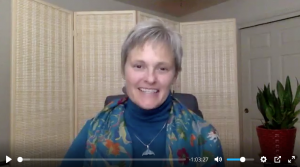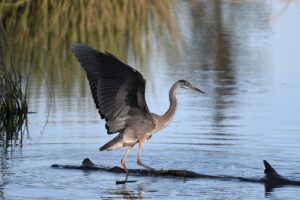
Many years ago, a young great blue heron taught me a valuable lesson about interspecies communication that I continue to share with my students.
This summer, I had the opportunity to revisit that lesson, and experience a magical event with another heron.
Here are those stories!
I Just Got Here
When I lived in Arizona, one of my favorite things to do in the summer was to go down to the creek near my home in the evenings for a swim. There were many great blue herons who made their home near the creek, and I loved seeing them and spending time near them. Usually, when I approached, they would regard me for awhile, and then take off in flight up or downstream to their next fishing area.
One evening, as I made my way up the creek, I saw a heron calmly feeding in the grasses at the side of the creek. As I watched, I saw him move slowly, put his head in the water, and sometimes, come up with a small fish.
My favorite swimming hole was beyond where the heron was fishing, and so I communicated to him that I would need to walk slowly past him and that I would do my best to not startle him. As I approached, I was surprised at how close I was able to get, just a few feet away, as he calmly continued his fishing.
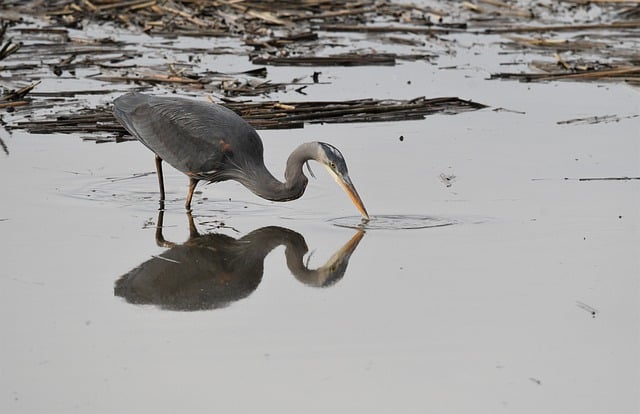
Although I could have attributed this calm to my communication with him, at a certain point, my thinking mind became involved and I wondered if this bird was okay. I had never had a heron allow me to come so close before without moving away.
“Are you okay?” I asked.
“I’m finding my food”, replied the heron.
Me: “Is your body okay? Do you feel well? Do you have any pain or discomfort?”
Heron: “I feel very strong and well. My body feels good.”
Me: “Can you fly?”
Heron: “I don’t understand what that is.”
Me: “Fly…move your wings, move your body through the air.” I did my best to give the heron an image of flying.
Heron: “No, I don’t do this. I just got here.”
At this point, I could feel that I was thinking and worrying, rather than simply being present with the heron and our experience. I was concerned that perhaps he had an injury and could not fly, but all I could feel from him when I truly let go of my worry and thinking was a sense of calm, peace, health, and focus: focus on fishing.
So, I let go, continued my walk up the creek, and proceeded with my swim.
However, I continued to ponder the heron’s communication, especially: “I just got here.”
I didn’t understand what this meant, and how, if at all, it related to my queries about flying.
When I got home, I called a man I knew in my community who was an experienced wildlife rehabilitator.
I told him about my experience, and immediately he was able to help me to understand what I had heard and seen.
He asked me if the heron had a lot of white on his neck, and I said, yes, he did. He explained to me that this was a juvenile heron, and that he had likely just fledged from his nest high in the cottonwood trees.
“The first thing they do is figure out how to find food and fish”, the wildlife expert said.
“Then, after they can feed themselves, they figure out how to fly. They do this on their own…the parents don’t teach them. Don’t worry, he will be just fine.”
I smiled, now understanding the heron’s communication: “I just got here.”
Literally, he had just arrived on the bank of the creek, after fledging out from his nest high in the trees.
It was a wonderful reminder for me of a couple of essential things that I often share with my animal communication students:
1. It is important to learn to recognize and feel the difference between human thinking and the sense of an accurate communication, even if the communication doesn’t seem to make sense.
In this case, I could feel the difference between my human thinking and worry, and what I was getting from the heron: a feeling of calm, purpose, and health.
2. Stay with the communication as it’s given, and don’t add interpretation, or discount it, even if it doesn’t make sense or you don’t understand it.
I didn’t know what “I just got here” meant, but after I learned more, it understood exactly what the heron had been communicating.
A Heron’s First Flight
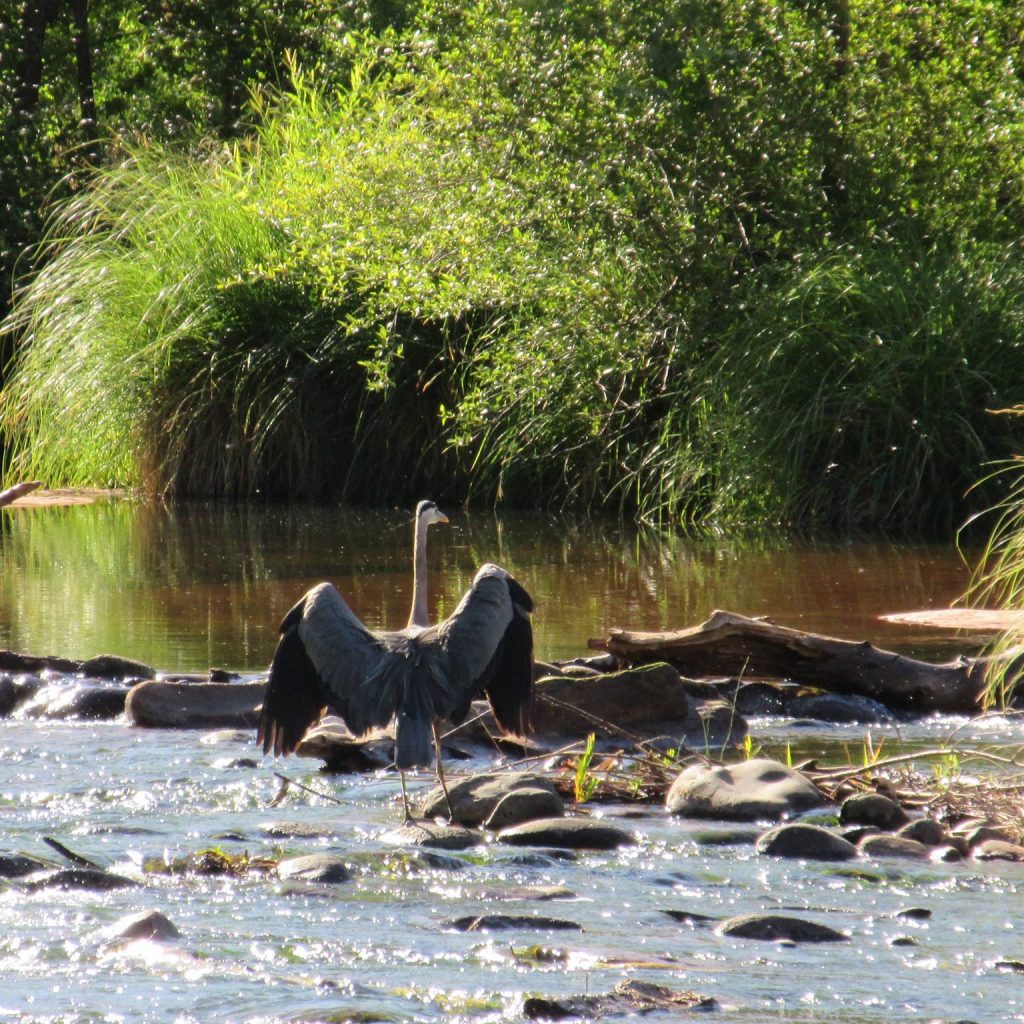
This summer, I went on a wilderness kayaking trip with friends on the Green River in Utah. It’s a magical place, deep in Canyonlands National Park. It’s an opportunity to unplug completely and spend time immersed in the energy of canyon, river, trees, and wild animals.
On our last night on the river, we were camped at the confluence of the Green River and the Colorado River. We made camp early, and as we were sitting by the rivers edge, we saw a great blue heron on the opposite bank. We watched through binoculars as the heron preened and preened his feathers, carefully tending each one with his beak.
Then, he sat down on the sand…and appeared to sleep. It was still mid-afternoon, and he rested for quite awhile. Then, he got up and moved slowly, poking his way among the grasses and branches near the river.
The heron stretched his legs out slowly, one at a time. Sometimes he’d lift one up, then the other, balancing on one at a time, a little wobbly.
I initially asked the same question that I had asked the heron so many years ago in Arizona: “Are you okay?”
And the answer, not surprisingly, was “Yes, just fine.”
We watched for several hours as the heron tended his feathers, and then slowly began to find food.
I noticed the white feathers on his neck and chest, and I understood what it was we were seeing.
“This is likely a juvenile heron who has just fledged”, I told my friends. “If we are lucky, we may be able to see his first flight.”
We watched the heron learn to fish. It was comical, and delightful. First a fish, then a twig or a branch which he would spit out and look at as it floated in the water, somewhat confused. “That didn’t taste good at all!” And then, the satisfaction of the right kind of food, a small fish.
As dusk fell, we continued to watch. I felt as though I was about to witness something magical, a once in a lifetime experience.
Slowly, the heron started to stretch and spread his wings. Clumsily at first, he attempted to leap in the air, and landed back down on the sand. A few more tries, a few more clunks.
And then, all at once, it was as if the flying just happened. The wings extended fully, he caught the current of air, he flapped his wings, and he took off! Flying, flying, flying, across the river, landing a little less than gracefully on the opposite bank, just downstream from where we were camped.
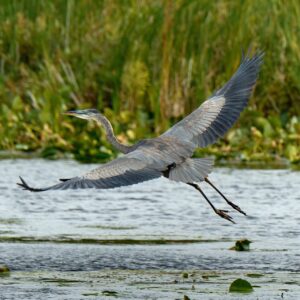
Our small group clapped and cheered as we witnessed the heron’s first flight. After he landed, I could feel his surprise and excitement, too: “Oh! THAT’S how it works!” And after a few minutes of gathering himself back together, he took off downriver again.
A few hours later, as I was tucked into my sleeping bag and darkness had fallen, I heard the unique call of a heron making his way back upriver.
“He’s back”, I realized. I heard a kind of clumsy, loud scrambling in the branches across the river, and realized that the heron had likely returned to roost near the nest that until early that day had been his home.
The magic of this moment has stayed with me. I felt such joy at being able to witness this young heron’s first flight, and so much gratitude for what my heron teacher had taught me so many years ago.
I smile every time I think about this experience, and how our small group of humans and this heron were able to share this beautiful moment in time together–as different species with different experiences, but united in our connection to the river, the trees, the sand, and the sky.

